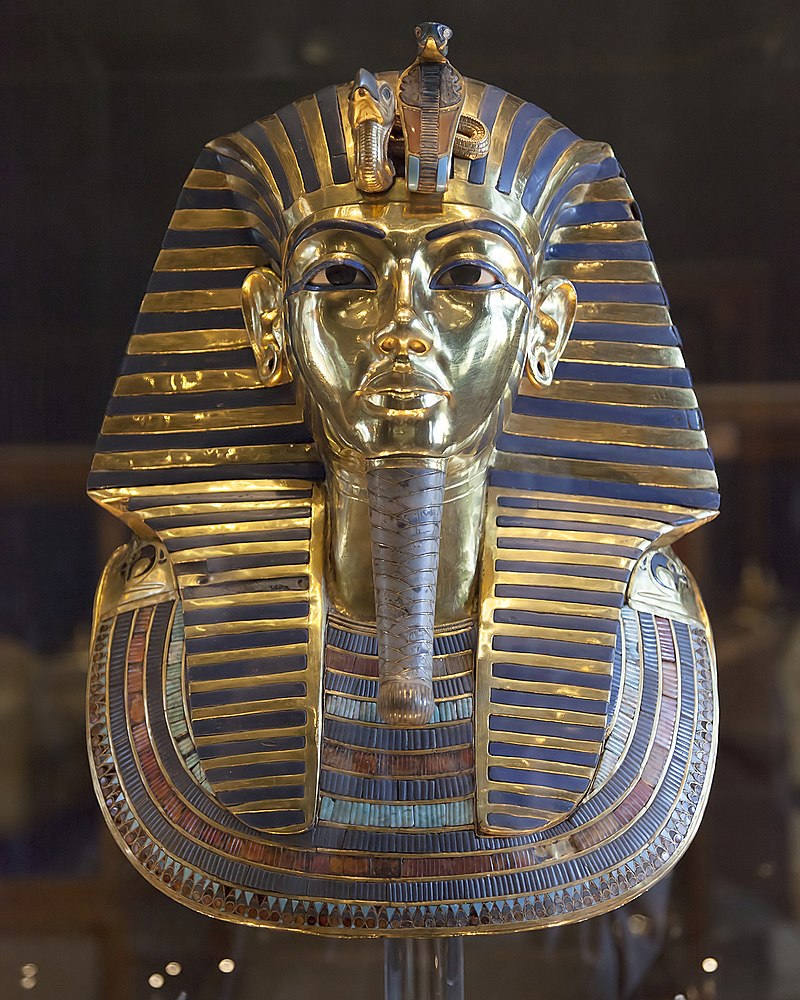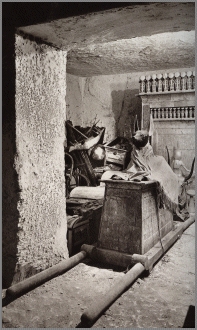"Graverob-Dungeoneering. Yeah, dungeoneering." (Part 1 - Egypt)
Having discussed what constituted coins before coins were a thing, I now want to focus attention on what one would find in a "dungeon". For most RPG settings, the primary treasure, the one found in amounts exceeding all other things, is coins. But coins don't exist. So what is my treasure then?
In the context of the ancient near east, the "typical RPG dungeon" would in reality be a tomb or funerary hoard. While temples and palaces also had lots of goodies within them (which will be explored in other posts), this post will primarily focus on what is found in the closest approximation to the dungeon 4000 years ago: the tomb. And to narrow it down even further, this post will focus on an Egyptian tomb.
I will be listing a lot of items. I have included pictures of some of them. These images, and more, can be found at the following sites:
Tutankhamun (18th Dynasty, New Kingdom; 1332-1323 BC)
A great example of a pharaoh's tomb is Tutankhamun.
In order to help you visualize the tomb like one would a dungeon map, here are two layouts from the Wikipedia page on the Tomb of Tutankhamun:


I will primarily be referring to the first image, which looks like it came right out an RPG supplement.
The Corridor
The illustrious party of grave robbers heroes has made their way in the grave dungeon. They descend the stairs and stand in the corridor. The assumption is they've already fought all the bad guys and there won't be any in these upcoming areas. Obviously, that doesn't have to be the case, but this post focuses on treasure, not monsters.
What do they find?
- Bags of natron (embalming salts)
- Jars
- Flower garlands
- A wooden bust of the pharaoh
Nothing to write home about, though it makes sense since our party is not quite in the tomb. These items may be of some minor value, but they aren't the treasure they were hoping for.
They press on!
The Antechamber
The way to the antechamber is sealed. In fact, it is hidden. The entrance is blocked off by a plaster wall, which would bear the insignia of some long-ago high-ranking official who oversaw part of the construction. The party breaks the wall to find a doorway into the antechamber.
What do they find?
West Side: taken up by a tangled pile of furniture among which miscellaneous small objects, such as baskets of fruit and boxes of meat, were placed.
Southeast corner: several dismantled chariots
Northeast: a collection of funerary bouquets
North end: dominated by two life-size statues of Tutankhamun that flanked the entrance to the burial chamber
Additionally, there were animal heads, an alabaster chalice, a painted box depicting Tutankhamen in battle, a gilded and inlaid throne depicting Tutankhamun and Ankhesenamun, boxes of clothing including tunics, shirts, kilts, gloves, sandals, and cosmetic products. In scattered remains there were pieces of gold, semiprecious stones from a corselet (armor), and a wooden mannequin.
Reassembled Chariot

Alabaster Chalice

Painted Chest

Corselet

Now these are some goodies! Many medium-to-big ticket items here: chariots, chalice, furniture, corselet, chest. The party look around and notice another plaster section of the wall...
The Annex
Behind this plaster wall, hidden from view, is the entrance to the annex. The wall is broken, the doorway is revealed, the short hallway is traversed.
What do they find?
- Beds
- Stools
- Stone and pottery vessels containing wine and oils
- Various food stuffs
- Shabtis
- Wooden models
- Weapons - bows, javelins, khopesh-swords
- Shields - ceremonial
- Children's things, like toys, a box of paints, a fire-lighting kit
Ceremonial Shield

Shabtis

These shabti are meant to be "stand-ins" for the deceased in the afterlife. The afterlife was like real life, but better. However, there was still work had to be done. A shabti was good for a year of work as a stand-in, so the deceased could continue to enjoy their afterlife. Once there were no more shabti to do the work, the deceased was put to work for their king Osiris. As above, so below, y'know?
You can learn more here: Grave Goods
Senet Game-Board

More goodies! While most of it would be of little value to the PCs, like children's toys or stools, the weapons and armor, especially the ornate pieces, will be quite valuable. Plus, those shabti dolls are gilded with gold, so those should be taken too.
At this point, they've got a lot of big-ticket and just plain big items. But surely this isn't all the treasure, right? That fellow at the bar mentioned immense riches.
He wasn't lying to us, right?
The Burial Chamber
The PCs re-enter the antechamber and find the 3rd doorway to the Burial Chamber, breaking the plaster wall down as before.
What do they find?
So much. So so much.
First and foremost, they find the outer shrine. Within the outer shrine are three nested shrines. All of these shrines are gilded with gold, by the way. The shrines also have passages from the Egyptian Book of the Dead on them.
Next, within the last of these shrines is a stone sarcophagus. Within the stone sarcophagus are three nested coffins. The first two are also gilded with gold. The final coffin is constructed out of 243 pounds of gold. To give you some perspective, the final coffin alone is worth $6,600,000. Within the final coffin is Pharaoh Tutankhamen.
Visualization

Another Visualization

Within Pharaoh Tutankhamen's funerary wrapping are 143 items, including clothing, jewelry, daggers, precious gems, more gold clothing, and, of course, the golden mask of Tutankhamen.
The Mask of Tutankhamen

And that's just the main ticket item. There's still a room around them, containing various other items - jars, animal fetishes, oars, walking sticks, a "magic brick" in each wall. These "magic bricks" contained passages from Spell 151 of the funerary Book of the Dead.
Imiut Fetishes

This is the big score! If the party can get this out of the tomb, they will be set for this life and every life after. I mean, this is the guy! And then they might notice one more wall with one of the seals on it. Y'know, the seals that get imprinted on plaster walls...
The Treasury
A statue of the jackal god Anubis stands atop a shrine on carrying poles. That's what greets the party first. In front of the statue is another "magic brick". Behind the shrine is a canopic chest containing Tutankhamen's internal organs. Beyond these are many wooden pieces - models, sculptures, and more shabtis. Various boxes are about, containing many pieces of jewelry. Additionally, two more coffins containing stillbirths are present.
Entrance to the Treasury

Canopic Chest
This is going to take the party multiple days, if not weeks, to clear out. But, if they should succeed, they will be the wealthiest people in the area, if not one of the wealthiest people on the planet. Of course, graverobb-dungeoneering is frowned upon by certain individuals. And that's a lot of gold all of a sudden. Surely somebody will start asking questions...
Miscellaneous Thoughts & Considerations
- Reality Your PCs probably aren't robbing the actual tomb of Tutankhamen. This tomb is used to showcase the wealth a dungeon can hold without a single coin within it. The items within an Egyptian tomb were not meant as displays of wealth primarily; they were meant to function as items the deceased could enjoy in the afterlife. That's why there is food-stuffs, furniture, and clothing. This isn't a dragon's hoard; this is a person's belongings believed to be taken with them to the afterlife.
What is even crazier to think about is the expedition which retrieved these items came roughly 3200 years after the tomb was created, and this was the stuff that was left. There was much evidence of previous grave robbing I largely skipped over.
- The Game These articles provide great inspiration and information on what to stock a dungeon from 1300 BC with - statues, furniture, clothing, weapons, shrines, internal organs, chests, games, jars, magic, jewelry, gems, etc. Additionally, there would probably be a lot of enemies here - undead, animated statues, the lich (There's literally a "phylactery" in the Treasury, hidden away!). There would also probably be many mundane and magical traps. Breaking the walls would definitely trigger a trap, or walking through the doorways after breaking the walls. The magic bricks and inscriptions of various texts are dripping with "magic trap" energy.
The dungeon itself is sectioned off by walls. The lazy party may not even realize they missed two or three rooms. It isn't a given they bust all the walls down, especially after finding the Burial Tomb. And finding all this stuff is one thing; how on earth are they getting it out? It isn't a sack of coins to hold in a hand; it is a disassembled chariot or a 240 pound golden lid.
- The Setting Grave robbing would probably get you killed. Grave robbing a king's grave would absolutely get you killed. But we aren't grave robbing; we are dungeoneering. A helpful distinction that the owner of the land the dungeon exists in probably won't take into consideration when they kill you for stealing. The party will have to be careful with their ill-gotten gains or have some form of official permission to dungeoneer.
What happens when they get all their treasure out? Who gets to claim it? How much do they get to keep? How are they viewed by the locals and authorities, both state and religious? Heroes? Criminals? Heretics? These are all things to consider now that the party has gone from rags to riches. I plan to, eventually, write up a post on patronage in the ancient near east. I will discuss this setting aspect then.
Closing Remarks
I love learning about the Ancient Near East. It is a passionate area of study of mine. I find immense inspiration from this time period for my own game. I hope you do too, because I think this stuff is rad.
As for what is next, I'll be doing a Mesopotamian burial tomb, then a Neo-Assyrian tomb. I think the time periods and places they span should give a solid foundation for imagining dungeon treasures. Then probably palaces and temples of different places and time periods within the ancient near east, for the same reasons. Tombs, temples, and tpalaces are great historical examples to inspire the setting. Then I'll just make a bunch of treasure tables until my eyes bleed. By then I'll probably be 90 years old and dead. Better buy a shabti or two.
